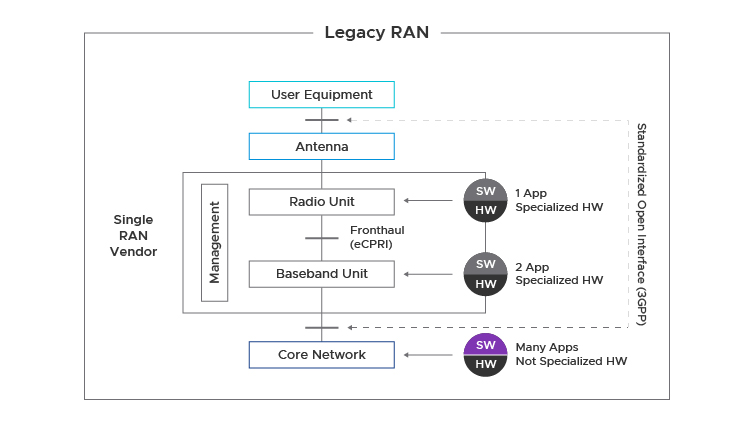The telecommunications industry is the midst of a seismic shift from a closed radio access network (RAN) to an open one (O-RAN). This shift is not only rocking the world of the communication service providers (CSPs) themselves, but also the worlds of traditional and non-traditional vendors and partners.
In fact, open RAN (O-RAN) is expected to represent more than 10% of the overall RAN market by 2025, according to the recently published report by Dell’Oro Group. Other industry analysts agree. Omdia states that open RAN revenues will reach $3.2 billion by 2024 and Appledore Research claims that “over the next 10-15 years, all RANs will become open RANs”. These are very significant numbers for something that has gone from conceptual to real-world build outs in a relatively short timeframe. Let’s examine what is driving this movement and how you can take advantage of it, without risking quality and reliability.

What is O-RAN?
As its name implies, the concept of open RAN takes a traditionally closed network and opens it up. At a basic level, O-RAN means virtualizing and disaggregating the baseband unit (BBU) functions, separating the control plane from the data plane and opening up fronthaul interfaces.


Virtualizing the RAN means decoupling the radio software from the underlying hardware by running it on a virtualization layer. More specifically, it involves virtualizing the BBUs so they can run as software on generic, industry standard hardware instead of specialized hardware. The BBU is split into multiple virtual functions. By logically splitting out these functions, CSPs have much more flexibility in terms of where they place their workloads and economies of scale through centralization.
Why would you want to do this?
CSPs are looking to O-RAN as a way to re-structure how the RAN is organized and run, and future-proof it for long-term innovation. The ultimate vision for O-RAN is to disaggregate the network and make it more open, fostering greater choice in a traditionally closed market. This will provide a strong foundation for CSPs to offer more innovative solutions to enterprise and consumer customers, as well as partners within their broader ecosystem.
The ultimate goal is to secure a return on 5G investments and monetize the network by enabling new applications and services, especially at the edge.
Why now?
Today’s landscape in the RAN is dominated by 3 major network equipment providers which results in limited competition and therefore limited creativity. The software and hardware is pre-integrated and interlocked from a single vendor, usually with proprietary interfaces. This prevents smaller software vendors from being able to create innovative apps to run on top of the closed system. Release cycles tend to be long (6-12 months) and CSPs must rely on vendors for changes to the software. While these solutions are tried and true, it is very hard to foster innovation in this environment. As new applications and trends emerge, such as cloud gaming, industrial IoT and work from home, CSPs will need to be able to anticipate these new trends and react fast. Agility and programmability will be key.
What’s the benefit?
The benefits of implementing an open RAN are multifold and include both qualitative and quantitative benefits.

Flexibility, Scalability & Agility are gained by:
- best-of-breed solutions
- open architecture and interfaces for interoperability with new innovators
- programmability for dynamic responses to a changing landscape
Cost Reductions and Operational Efficiencies are gained by:
- Utilizing generic, industry standard hardware with general-purpose processors for central units (CUs) and/or distributed units (DUs)
- Running CU and DU network functions on pooled compute hardware for economies of scale
- Performing remote software upgrades of CUs and DUs versus truck rolls
- Centralizing operations creates consistency and gives rapid visibility in the event new changes or upgrades are affecting the network
What to do now?
If you are like most of us, change, especially on this scale, is daunting. Yes, it logically represents a tremendous opportunity for new innovations at faster speeds and lower costs. But it also represents a great deal of uncertainty and potential stress. And who wants more stress after 2020?
VMware is here to help. We’ve taken a phased and very methodical approach to migrating your networks to open RAN, at the pace you are comfortable with. In most cases, it is not feasible to do it all at once, nor have all the standards be defined. In our whitepaper, O-RAN: Defining the Path for Innovation the RAN, we walk you through our step-by-step methodology.
We’ve done our homework, so you don’t need to start from scratch. Leading the way, we are working with large CSPs to build out deployments in real world environments. We are focused on delivering real-time, high-volume performance with security built in from the ground up. In our joint labs, we’ve set up a continuous integration and continuous delivery (CI/CD) pipeline, thoroughly vetting best-of-breed CNF and VNF workloads from various vendors on our platform to ensure that optimal functionality is reached. Zero touch provisioning and consistent operations across all locations, large or small, speeds time-to-deployment and reduces management headaches. All of this gives you the ability to introduce new services with confidence, at a much faster pace.
VMware is actively working with CSPs all over the world to help them break free to from the limitations of legacy RAN networks and bring the economics of cloud to the RAN. Join us in the conversation today.
For more information on how VMware can help transform the RAN:
- Visit our website – telco.vmware.com/solutions/ran
- Read our white paper (referenced above) – O-RAN: Defining the path for innovation in the RAN
- Check out this analyst report – Appledore Research: Why the Future is Open
Discover more from VMware Telco Cloud Blog
Subscribe to get the latest posts sent to your email.









